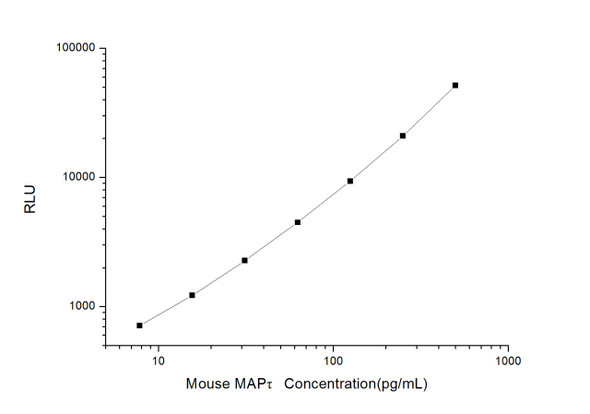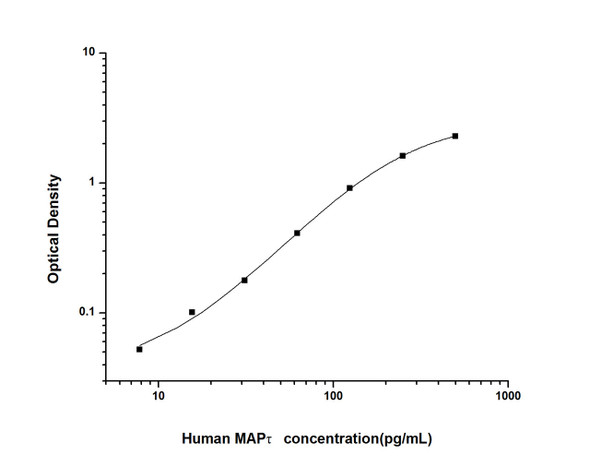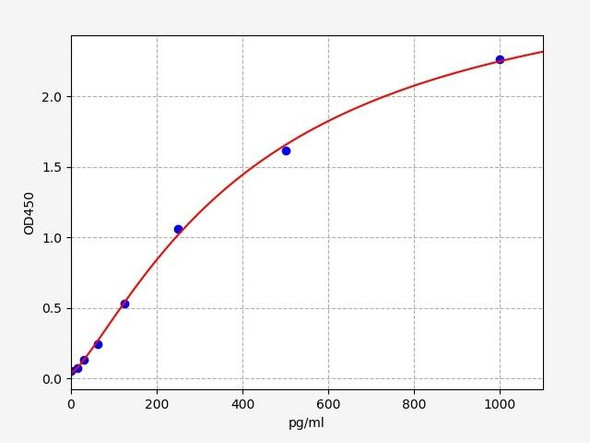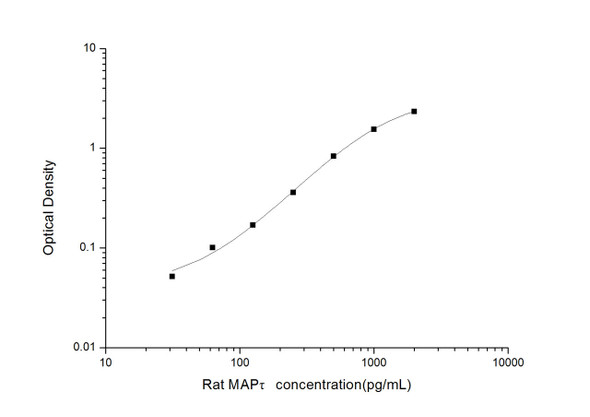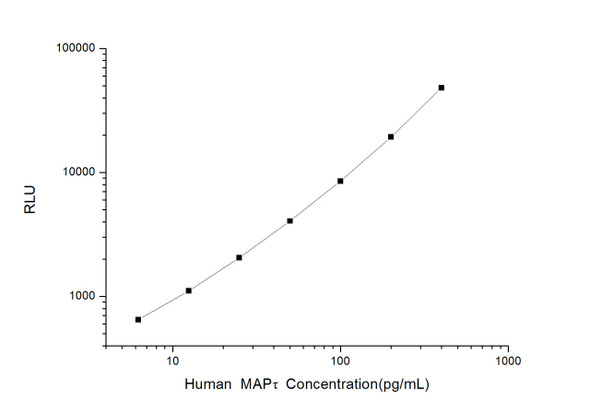Mouse Cell Biology ELISA Kits 1
Mouse MAPtau (Microtubule Associated Protein Tau/Tau Protein) ELISA Kit (MOES01529)
- SKU:
- MOES01529
- Product Type:
- ELISA Kit
- Size:
- 96 Assays
- Uniprot:
- P10637
- Sensitivity:
- 9.38pg/mL
- Range:
- 15.63-1000pg/mL
- ELISA Type:
- Sandwich
- Synonyms:
- MAPT, DDPAC, FTDP-17, MAPTL, MSTD, MTBT1, MTBT2, PPND, TAU
- Reactivity:
- Mouse
- Sample Type:
- Serum, plasma and other biological fluids
Description
| Assay type: | Sandwich |
| Format: | 96T |
| Assay time: | 4.5h |
| Reactivity: | Mouse |
| Detection Method: | Colormetric |
| Detection Range: | 15.63-1000 pg/mL |
| Sensitivity: | 9.38 pg/mL |
| Sample Volume Required Per Well: | 100µL |
| Sample Type: | Serum, plasma and other biological fluids |
| Specificity: | This kit recognizes Mouse MAPtau in samples. No significant cross-reactivity or interference between Mouse MAPtau and analogues was observed. |
This ELISA kit uses Sandwich-ELISA as the method. The micro ELISA plate provided in this kit has been pre-coated with an antibody specific to Mouse MAPtau. Standards or samples are added to the appropriate micro ELISA plate wells and combined with the specific antibody. Then a biotinylated detection antibody specific for Mouse MAPtau and Avidin-Horseradish Peroxidase (HRP) conjugate are added to each micro plate well successively and incubated. Free components are washed away. The substrate solution is added to each well. Only those wells that contain Mouse MAPtau, biotinylated detection antibody and Avidin-HRP conjugate will appear blue in color. The enzyme-substrate reaction is terminated by adding Stop Solution and the color turns yellow. The optical density (OD) is measured spectrophotometrically at a wavelength of 450 nm ± 2 nm. The OD value is proportional to the concentration of Mouse MAPtau. The concentration of Mouse MAPtau in samples can be calculated by comparing the OD of the samples to the standard curve.
| UniProt Protein Function: | Tau: a microtubule-associated protein that regulates microtubule assembly and stability. Apparently involved in the establishment and maintenance of neuronal polarity. Mutations can result in several neurodegenerative disorders such as Alzheimer's disease, Pick's disease, frontotemporal dementia, cortico-basal degeneration and progressive supranuclear palsy. The C-terminus binds axonal microtubules while the N-terminus binds neural plasma membrane components, suggesting that tau functions as a linker. Axonal polarity is predetermined by tau localization (in the neuronal cell) in the domain of the cell body defined by the centrosome. Nine differentially spliced isoforms have been described. The short isoforms allow plasticity of the cytoskeleton, whereas the longer isoforms may preferentially play a role in its stabilization. |
| UniProt Protein Details: | Protein type:Cytoskeletal Chromosomal Location of Human Ortholog: 17q21. 1 Cellular Component: microtubule; microtubule associated complex; growth cone; axon; tubulin complex; plasma membrane; axoneme; cytosol Molecular Function:protein binding; enzyme binding; structural constituent of cytoskeleton; microtubule binding; apolipoprotein binding; protein kinase binding; SH3 domain binding Biological Process: axon extension; apoptosis; positive regulation of microtubule polymerization; positive regulation of axon extension; axon cargo transport; neuron migration; microtubule cytoskeleton organization and biogenesis; adult walking behavior; regulation of microtubule polymerization; mitochondrion transport along microtubule; negative regulation of intracellular transport; generation of neurons; regulation of autophagy; cell structure disassembly during apoptosis Disease: Supranuclear Palsy, Progressive, 1; Pick Disease Of Brain; Frontotemporal Dementia; Parkinson-dementia Syndrome; Parkinson Disease, Late-onset; Frontotemporal Lobar Degeneration With Tdp43 Inclusions, Grn-related |
| NCBI Summary: | This gene encodes the microtubule-associated protein tau (MAPT) whose transcript undergoes complex, regulated alternative splicing, giving rise to several mRNA species. MAPT transcripts are differentially expressed in the nervous system, depending on stage of neuronal maturation and neuron type. MAPT gene mutations have been associated with several neurodegenerative disorders such as Alzheimer's disease, Pick's disease, frontotemporal dementia, cortico-basal degeneration and progressive supranuclear palsy. [provided by RefSeq, Jul 2008] |
| UniProt Code: | P10637 |
| NCBI GenInfo Identifier: | 294862258 |
| NCBI Gene ID: | 4137 |
| NCBI Accession: | NP_001116538. 2 |
| UniProt Secondary Accession: | P10637,P10637, P19332, |
| UniProt Related Accession: | P10636 |
| Molecular Weight: | 80kDa |
| NCBI Full Name: | microtubule-associated protein tau isoform 6 |
| NCBI Synonym Full Names: | microtubule associated protein tau |
| NCBI Official Symbol: | MAPT |
| NCBI Official Synonym Symbols: | TAU; MSTD; PPND; DDPAC; MAPTL; MTBT1; MTBT2; FTDP-17; PPP1R103 |
| NCBI Protein Information: | microtubule-associated protein tau |
| UniProt Protein Name: | Microtubule-associated protein tau |
| UniProt Synonym Protein Names: | Neurofibrillary tangle protein; Paired helical filament-tau |
| Protein Family: | Tautomerase |
| UniProt Gene Name: | MAPT |
| UniProt Entry Name: | TAU_HUMAN |
As the OD values of the standard curve may vary according to the conditions of the actual assay performance (e. g. operator, pipetting technique, washing technique or temperature effects), the operator should establish a standard curve for each test. Typical standard curve and data is provided below for reference only.
| Concentration (pg/mL) | O.D | Average | Corrected |
| 1000 | 2.428 2.478 | 2.453 | 2.368 |
| 500 | 1.641 1.689 | 1.665 | 1.58 |
| 250 | 0.943 0.943 | 0.943 | 0.858 |
| 125 | 0.474 0.51 | 0.492 | 0.407 |
| 62.5 | 0.312 0.286 | 0.299 | 0.214 |
| 31.25 | 0.193 0.183 | 0.188 | 0.103 |
| 15.63 | 0.136 0.14 | 0.138 | 0.053 |
| 0 | 0.081 0.089 | 0.085 | -- |
Precision
Intra-assay Precision (Precision within an assay): 3 samples with low, mid range and high level Mouse MAPtau were tested 20 times on one plate, respectively.
Inter-assay Precision (Precision between assays): 3 samples with low, mid range and high level Mouse MAPtau were tested on 3 different plates, 20 replicates in each plate.
| Intra-assay Precision | Inter-assay Precision | |||||
| Sample | 1 | 2 | 3 | 1 | 2 | 3 |
| n | 20 | 20 | 20 | 20 | 20 | 20 |
| Mean (pg/mL) | 54.35 | 115.90 | 411.66 | 52.69 | 116.07 | 437.36 |
| Standard deviation | 3.79 | 5.27 | 20.67 | 2.71 | 6.94 | 13.34 |
| C V (%) | 6.97 | 4.55 | 5.02 | 5.14 | 5.98 | 3.05 |
Recovery
The recovery of Mouse MAPtau spiked at three different levels in samples throughout the range of the assay was evaluated in various matrices.
| Sample Type | Range (%) | Average Recovery (%) |
| Serum (n=5) | 93-106 | 100 |
| EDTA plasma (n=5) | 90-102 | 96 |
| Cell culture media (n=5) | 93-110 | 100 |
Linearity
Samples were spiked with high concentrations of Mouse MAPtau and diluted with Reference Standard & Sample Diluent to produce samples with values within the range of the assay.
| Serum (n=5) | EDTA plasma (n=5) | Cell culture media (n=5) | ||
| 1:2 | Range (%) | 91-105 | 90-106 | 97-114 |
| Average (%) | 99 | 96 | 104 | |
| 1:4 | Range (%) | 88-99 | 86-98 | 86-100 |
| Average (%) | 94 | 93 | 93 | |
| 1:8 | Range (%) | 94-108 | 86-98 | 85-100 |
| Average (%) | 99 | 91 | 92 | |
| 1:16 | Range (%) | 87-100 | 82-97 | 85-97 |
| Average (%) | 94 | 89 | 91 |
An unopened kit can be stored at 4°C for 1 month. If the kit is not used within 1 month, store the items separately according to the following conditions once the kit is received.
| Item | Specifications | Storage |
| Micro ELISA Plate(Dismountable) | 8 wells ×12 strips | -20°C, 6 months |
| Reference Standard | 2 vials | |
| Concentrated Biotinylated Detection Ab (100×) | 1 vial, 120 µL | |
| Concentrated HRP Conjugate (100×) | 1 vial, 120 µL | -20°C(shading light), 6 months |
| Reference Standard & Sample Diluent | 1 vial, 20 mL | 4°C, 6 months |
| Biotinylated Detection Ab Diluent | 1 vial, 14 mL | |
| HRP Conjugate Diluent | 1 vial, 14 mL | |
| Concentrated Wash Buffer (25×) | 1 vial, 30 mL | |
| Substrate Reagent | 1 vial, 10 mL | 4°C(shading light) |
| Stop Solution | 1 vial, 10 mL | 4°C |
| Plate Sealer | 5 pieces | |
| Product Description | 1 copy | |
| Certificate of Analysis | 1 copy |
- Set standard, test sample and control (zero) wells on the pre-coated plate and record theirpositions. It is recommended to measure each standard and sample in duplicate. Note: addall solutions to the bottom of the plate wells while avoiding contact with the well walls. Ensuresolutions do not foam when adding to the wells.
- Aliquot 100µl of standard solutions into the standard wells.
- Add 100µl of Sample / Standard dilution buffer into the control (zero) well.
- Add 100µl of properly diluted sample (serum, plasma, tissue homogenates and otherbiological fluids) into test sample wells.
- Cover the plate with the sealer provided in the kit and incubate for 90 min at 37°C.
- Aspirate the liquid from each well, do not wash. Immediately add 100µL of BiotinylatedDetection Ab working solution to each well. Cover the plate with a plate seal and gently mix. Incubate for 1 hour at 37°C.
- Aspirate or decant the solution from the plate and add 350µL of wash buffer to each welland incubate for 1-2 minutes at room temperature. Aspirate the solution from each well andclap the plate on absorbent filter paper to dry. Repeat this process 3 times. Note: a microplatewasher can be used in this step and other wash steps.
- Add 100µL of HRP Conjugate working solution to each well. Cover with a plate seal andincubate for 30 min at 37°C.
- Aspirate or decant the solution from each well. Repeat the wash process for five times asconducted in step 7.
- Add 90µL of Substrate Reagent to each well. Cover with a new plate seal and incubate forapproximately 15 min at 37°C. Protect the plate from light. Note: the reaction time can beshortened or extended according to the actual color change, but not by more than 30min.
- Add 50 µL of Stop Solution to each well. Note: Adding the stop solution should be done inthe same order as the substrate solution.
- Determine the optical density (OD value) of each well immediately with a microplate readerset at 450 nm.


